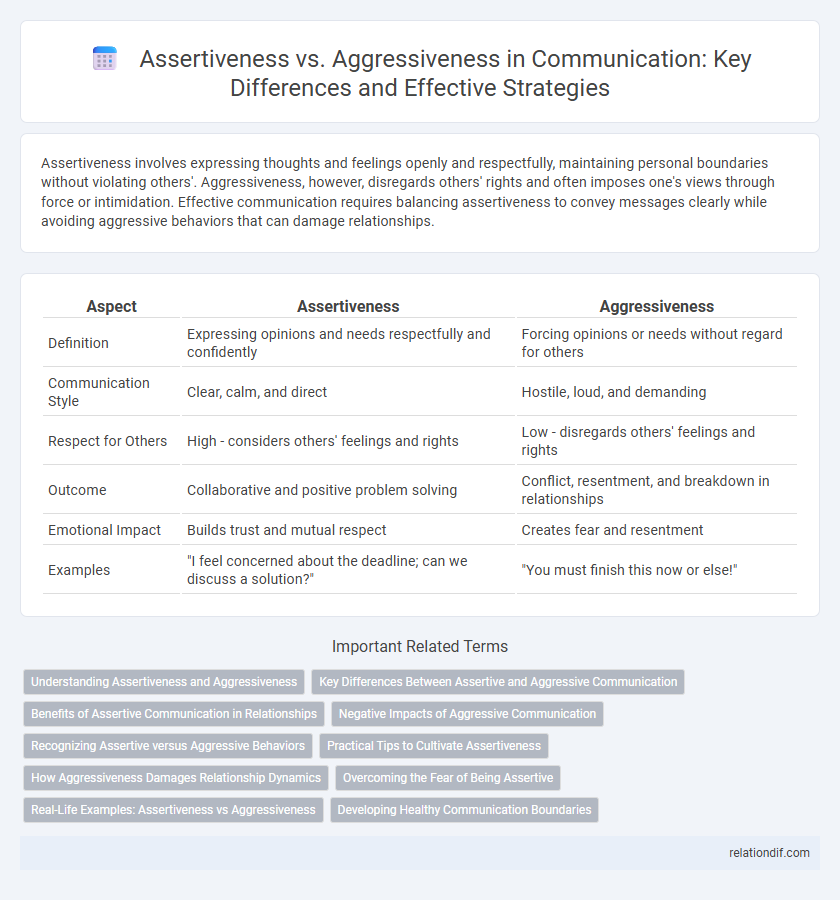Assertiveness involves expressing thoughts and feelings openly and respectfully, maintaining personal boundaries without violating others'. Aggressiveness, however, disregards others' rights and often imposes one's views through force or intimidation. Effective communication requires balancing assertiveness to convey messages clearly while avoiding aggressive behaviors that can damage relationships.
Table of Comparison
| Aspect | Assertiveness | Aggressiveness |
|---|---|---|
| Definition | Expressing opinions and needs respectfully and confidently | Forcing opinions or needs without regard for others |
| Communication Style | Clear, calm, and direct | Hostile, loud, and demanding |
| Respect for Others | High - considers others' feelings and rights | Low - disregards others' feelings and rights |
| Outcome | Collaborative and positive problem solving | Conflict, resentment, and breakdown in relationships |
| Emotional Impact | Builds trust and mutual respect | Creates fear and resentment |
| Examples | "I feel concerned about the deadline; can we discuss a solution?" | "You must finish this now or else!" |
Understanding Assertiveness and Aggressiveness
Understanding assertiveness involves expressing thoughts and feelings clearly and respectfully while maintaining open communication and mutual respect. Aggressiveness, in contrast, often disregards others' rights and feelings, leading to hostile or dominating behavior that damages relationships. Effective communication balances assertiveness to convey needs confidently without crossing into aggressiveness.
Key Differences Between Assertive and Aggressive Communication
Assertive communication expresses needs and opinions clearly and respectfully, promoting mutual understanding and cooperation. Aggressive communication often involves dominating or disrespecting others, leading to conflict and damaged relationships. Key differences include tone of voice, body language, and the intention behind the message--assertiveness aims for clarity and respect, while aggressiveness seeks control or intimidation.
Benefits of Assertive Communication in Relationships
Assertive communication enhances relationships by fostering mutual respect and clear understanding, reducing conflicts and misunderstandings. It allows individuals to express their thoughts and feelings honestly while maintaining empathy, promoting healthy dialogue and trust. This balanced approach strengthens emotional connections and supports long-term relationship satisfaction.
Negative Impacts of Aggressive Communication
Aggressive communication often leads to misunderstandings, damaged relationships, and increased conflict due to its confrontational and hostile tone. This behavior creates a toxic environment that undermines trust and inhibits constructive dialogue. Prolonged exposure to aggressiveness can cause stress, lower morale, and reduce overall team productivity.
Recognizing Assertive versus Aggressive Behaviors
Recognizing assertive behaviors involves identifying clear, respectful communication where individuals express their needs and boundaries without violating others' rights. Aggressive behaviors manifest as dominating, hostile language that seeks to control or intimidate, often disregarding others' feelings or perspectives. Understanding these distinctions enhances interpersonal skills and fosters healthier, more effective communication dynamics.
Practical Tips to Cultivate Assertiveness
Cultivating assertiveness involves practicing clear, direct communication while respecting others' boundaries and feelings. Use "I" statements to express needs and opinions without blaming or criticizing, such as "I feel..." or "I need...". Regularly rehearsing scenarios and maintaining calm body language helps reinforce confidence and reduces the tendency toward aggression.
How Aggressiveness Damages Relationship Dynamics
Aggressiveness in communication creates hostility and erodes trust, causing breakdowns in relationship dynamics. It often triggers defensiveness and resentment, making effective dialogue impossible. Maintaining assertiveness ensures respect and clarity, fostering positive and constructive interactions.
Overcoming the Fear of Being Assertive
Overcoming the fear of being assertive involves recognizing the difference between assertiveness and aggressiveness, where assertiveness conveys confidence and respect without hostility. Developing assertive communication skills requires practicing clear, direct expression of thoughts and feelings while maintaining empathy for others. Building self-awareness and gradually confronting fear through role-playing or feedback can reinforce positive assertive behavior and reduce anxiety in social interactions.
Real-Life Examples: Assertiveness vs Aggressiveness
Real-life examples highlight that assertiveness involves expressing opinions clearly and respectfully, such as calmly requesting a deadline extension to manage workload efficiently. Aggressiveness, by contrast, may manifest as shouting demands or interrupting colleagues, which escalates conflicts and damages professional relationships. Practicing assertiveness fosters collaboration and problem-solving, while aggressiveness often leads to resistance and breakdowns in communication.
Developing Healthy Communication Boundaries
Developing healthy communication boundaries requires distinguishing assertiveness from aggressiveness by expressing needs clearly and respectfully without infringing on others' rights. Assertiveness empowers individuals to communicate their thoughts and feelings effectively, fostering mutual understanding and trust. In contrast, aggressiveness often leads to conflict and breakdowns in communication, undermining relationships and collaboration.
assertiveness vs aggressiveness Infographic

 relationdif.com
relationdif.com